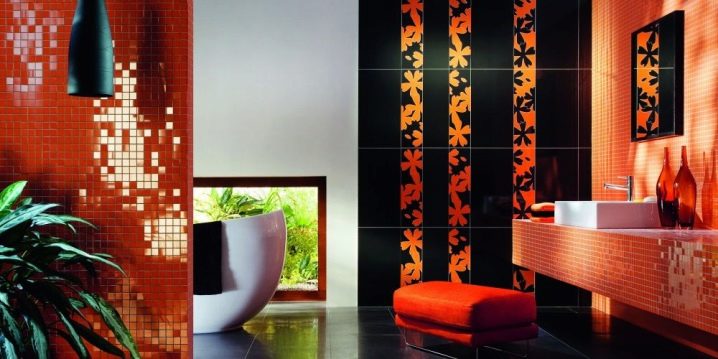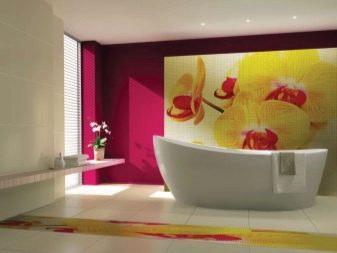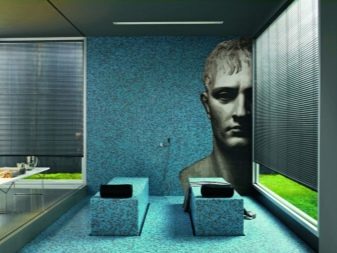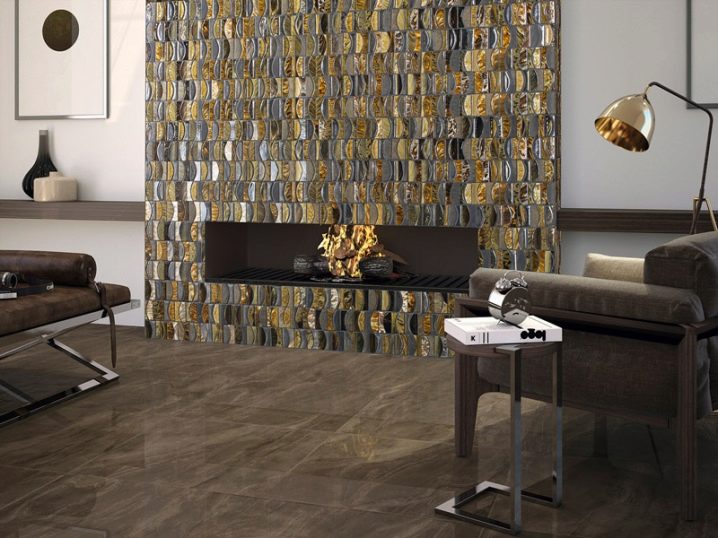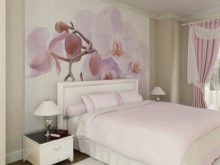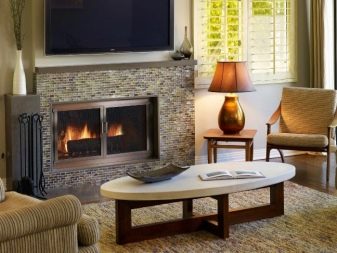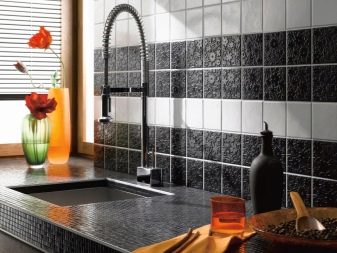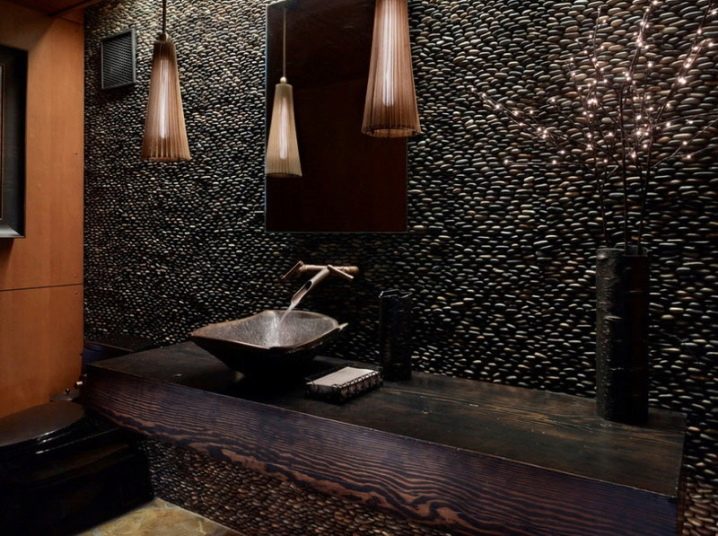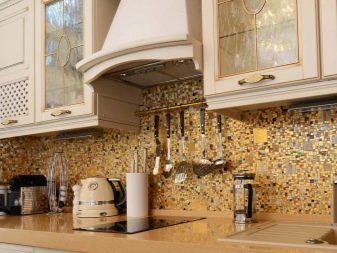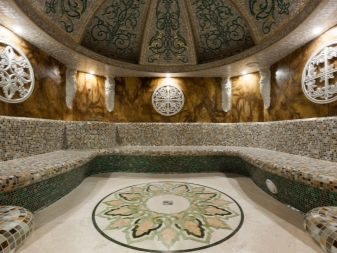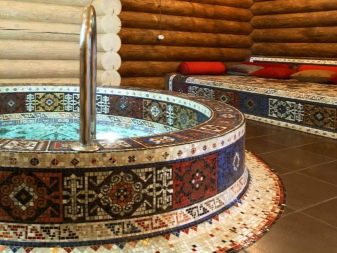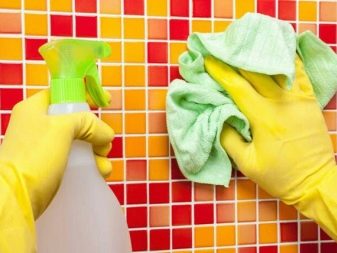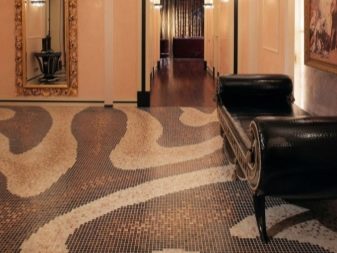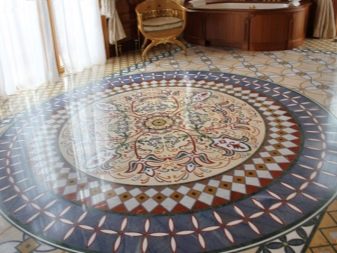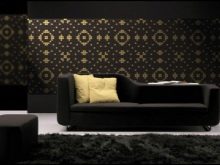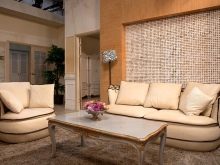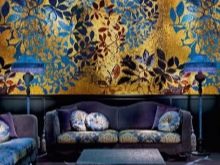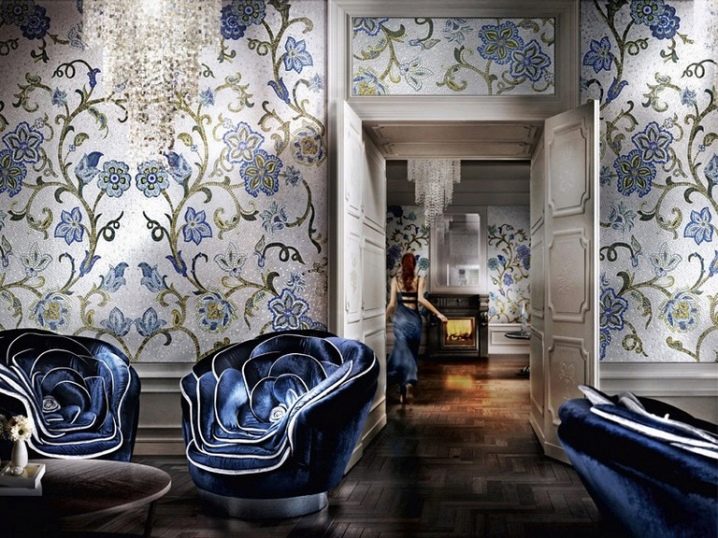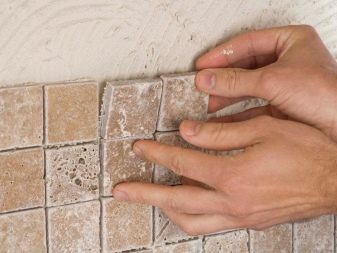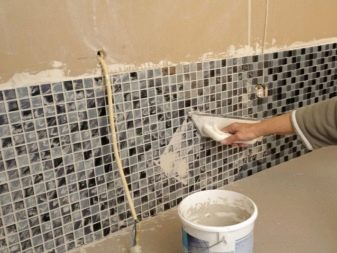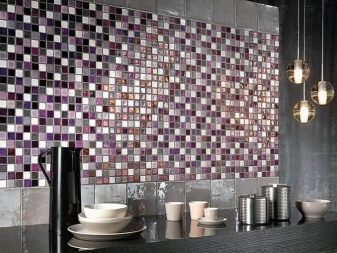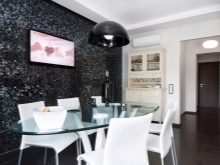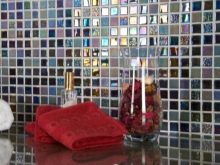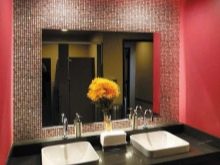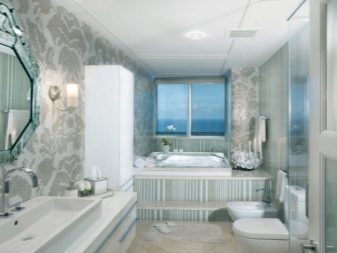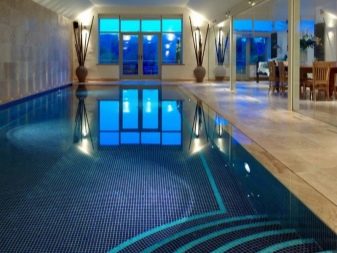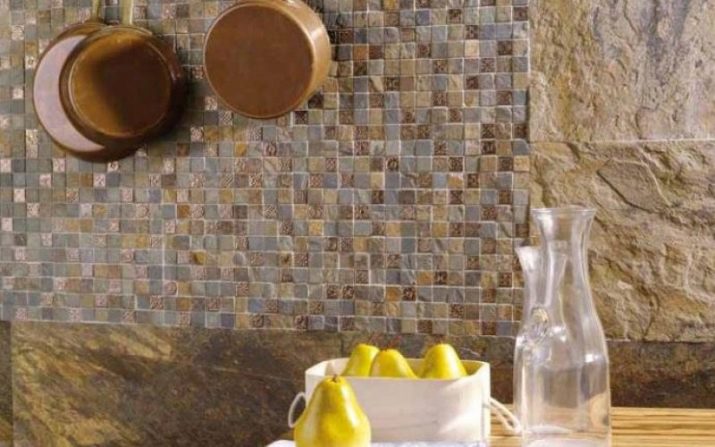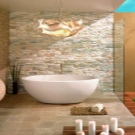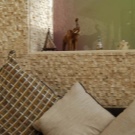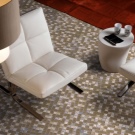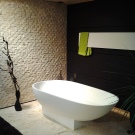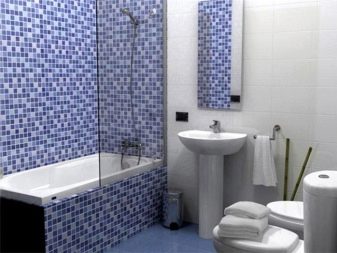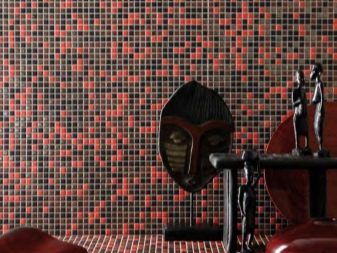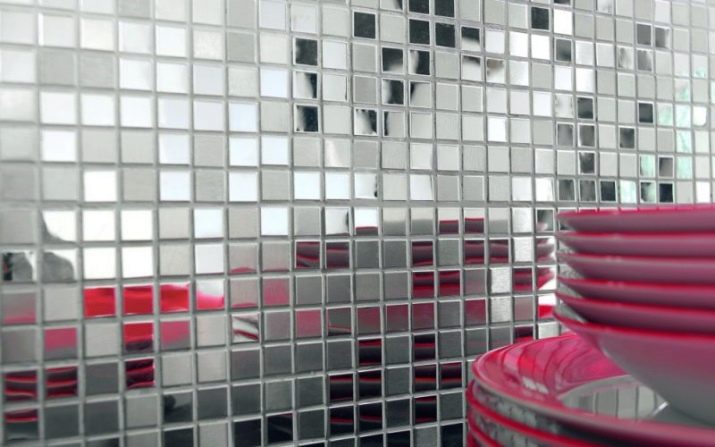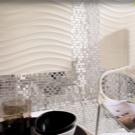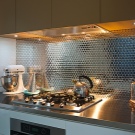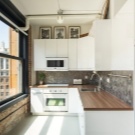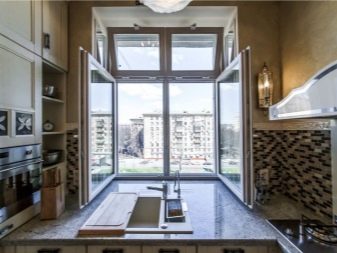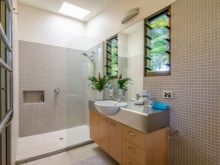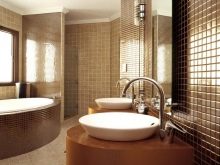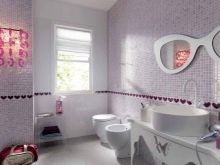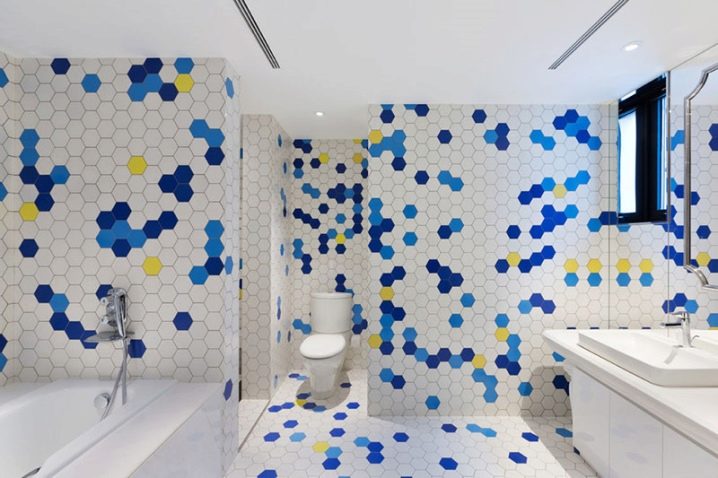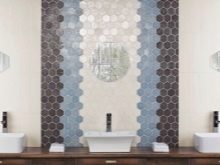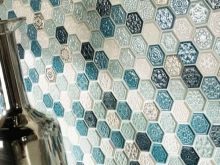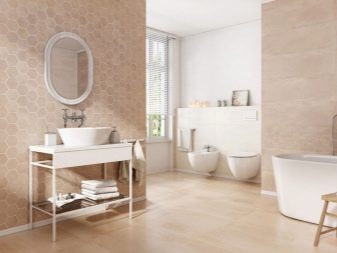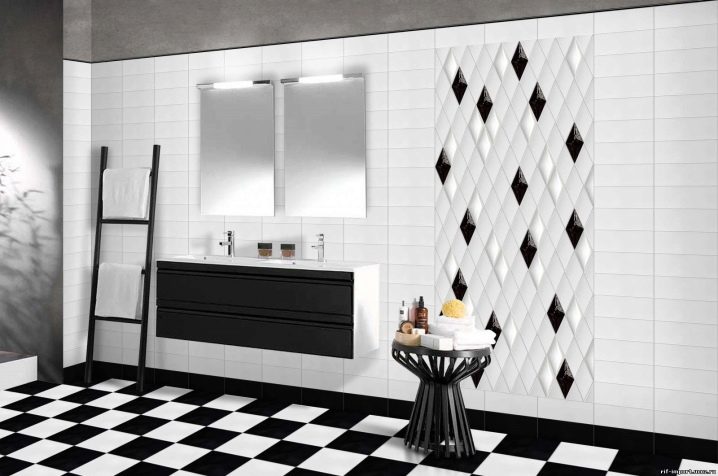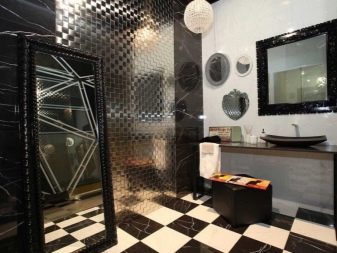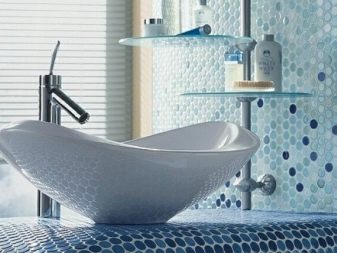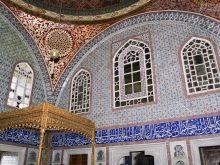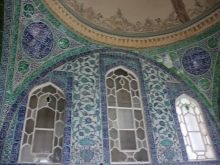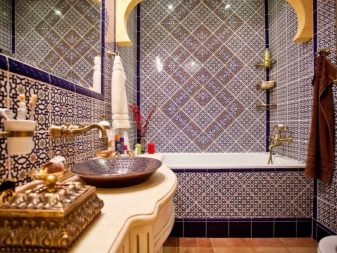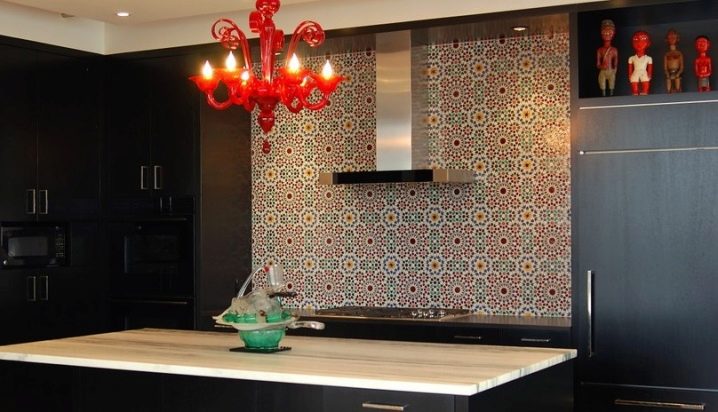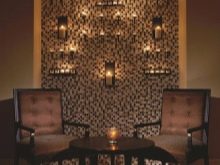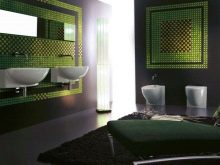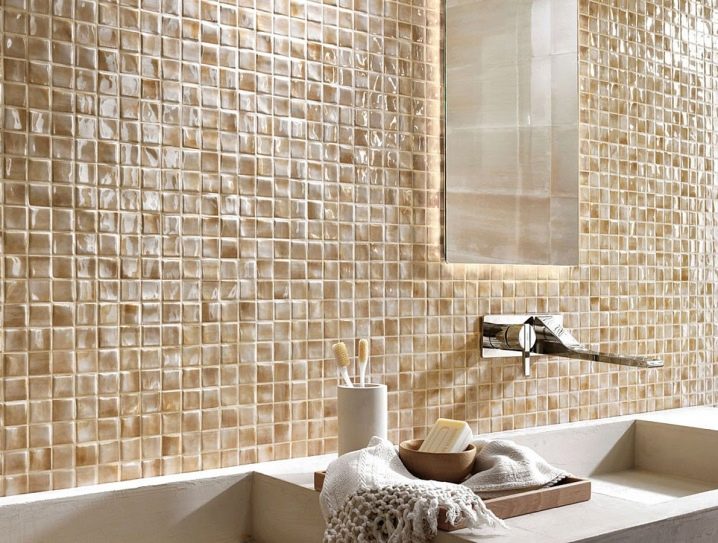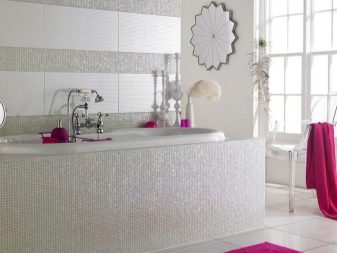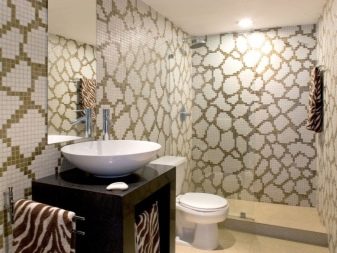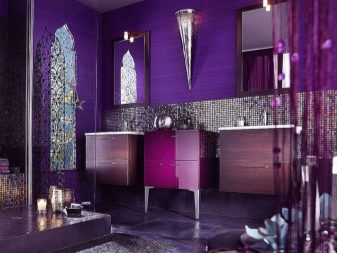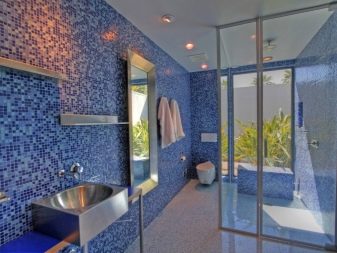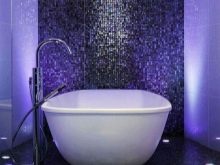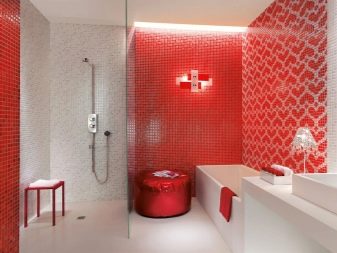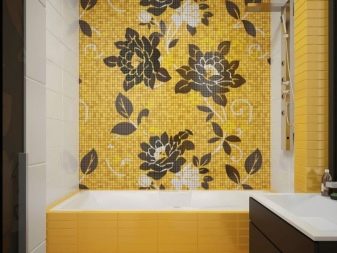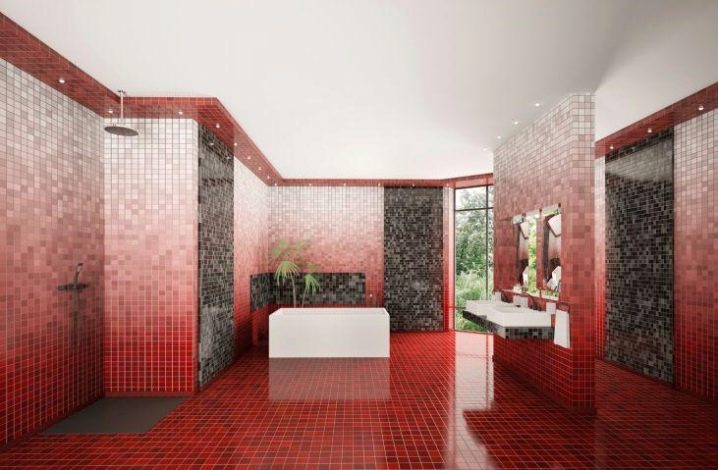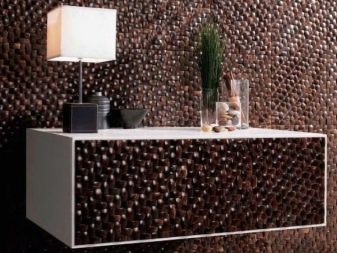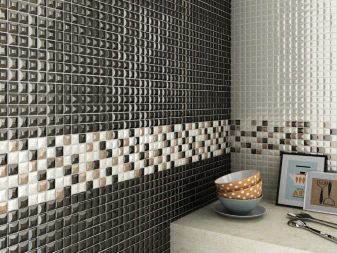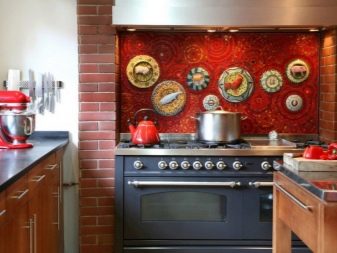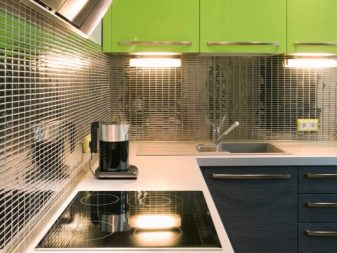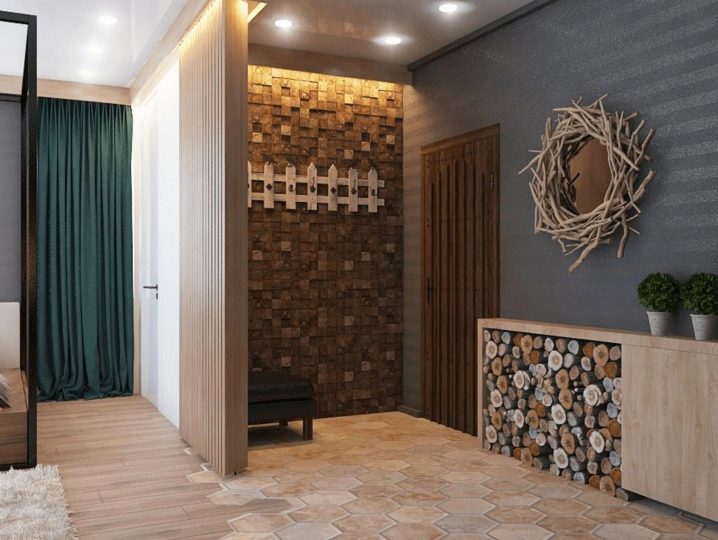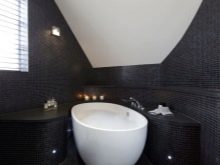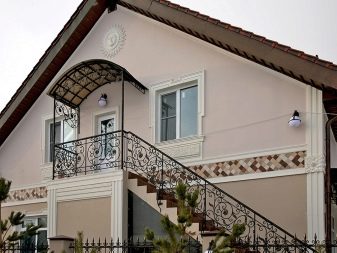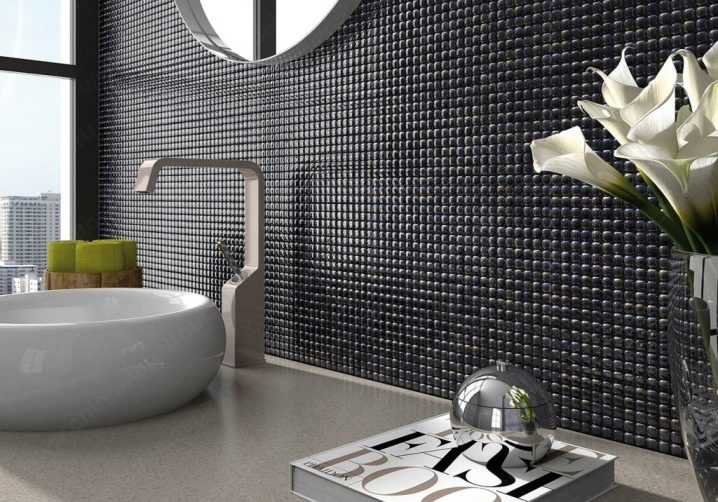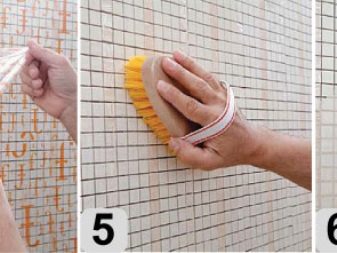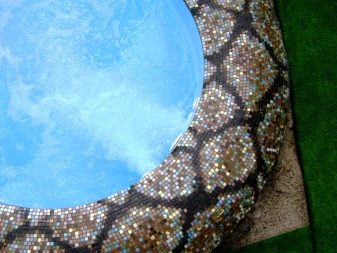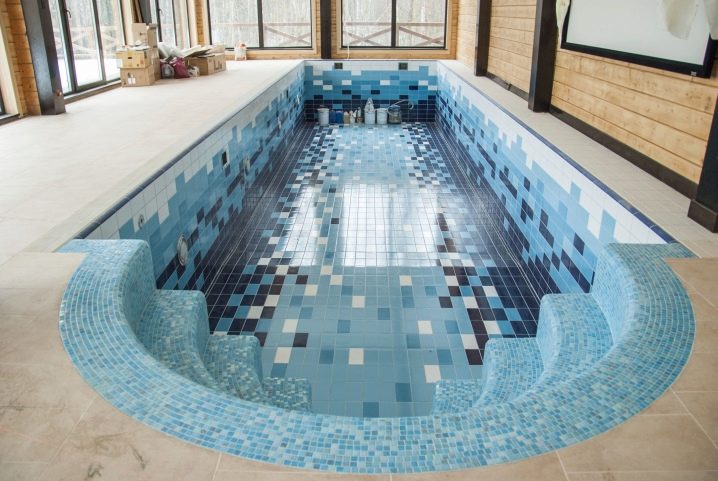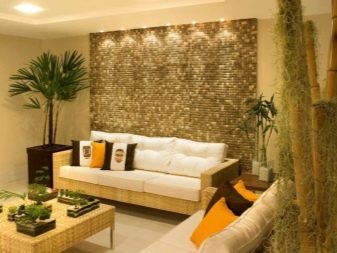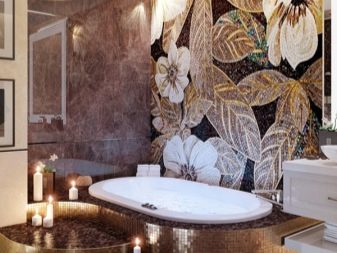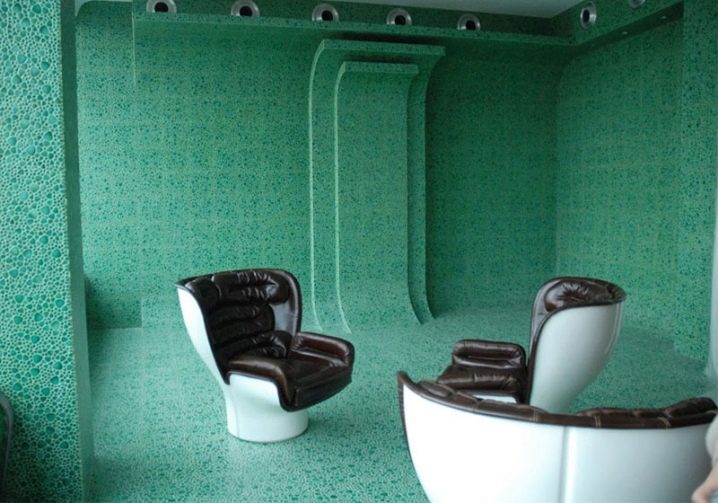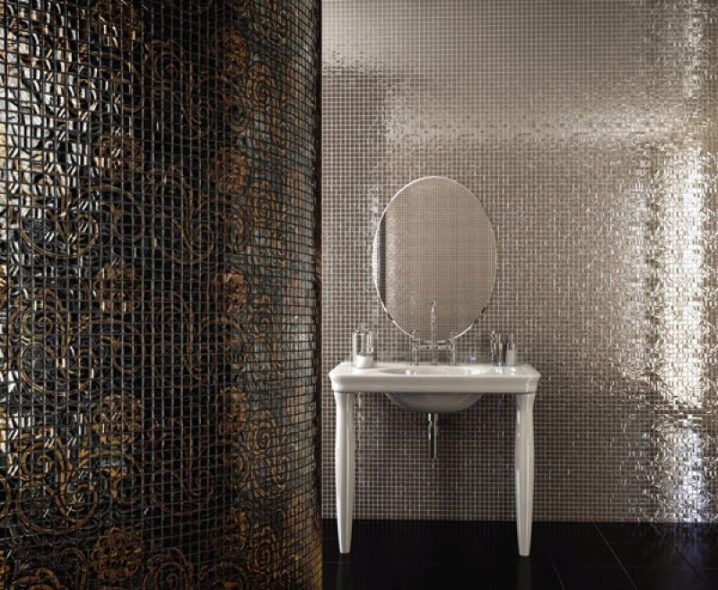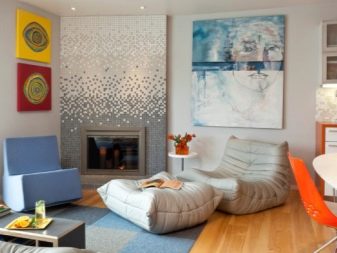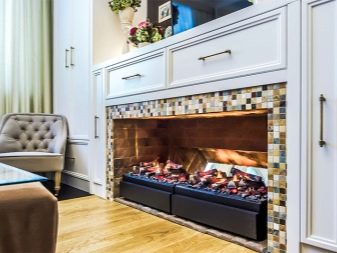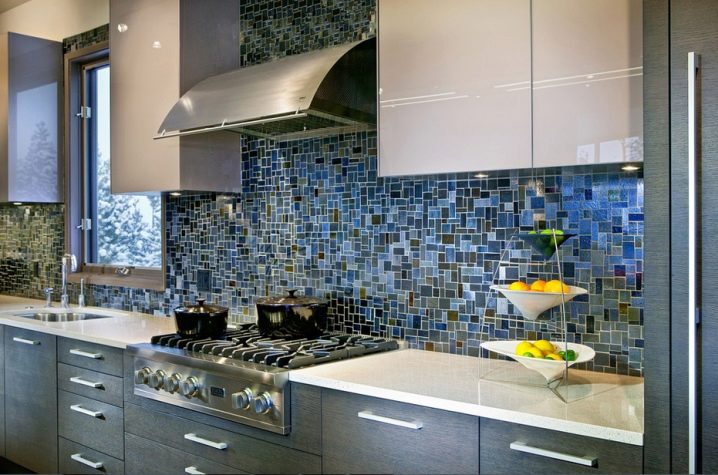Mosaic: features and its scope
The market of building materials is expanding every year - there are new types of finishing materials that are produced using the latest technologies. In this regard, buyers are lost in the choice of a wide range. One of the most popular types of finishes is mosaic, which can also vary in its properties. In order to understand the specifics of the material and its scope, we consider this coating in more detail.
Special features
Mosaic is a tile made in a special way on the basis of small parts of various materials, such as glass or ceramics. This interior design has been known since time immemorial - according to historians, the use of mosaics can be traced to the V century BC! ExactlyFrom the Middle East and the Mediterranean, the tradition has been to create intricate scenes and skillful panels on the floor and walls based on small individual elements.
Today this technology has not lost its popularity, rather, on the contrary, now it is at the top of the building trends. Thanks to the development of technology, it became possible to simplify and speed up the production of mosaic coatings as much as possible.
During the creation of a product, all its constituent elements are produced: tessera cells, a special substrate, binding soil, as well as patterns or designs are developed.
Of course, particularly pretentious consumers can create their own mosaic design, but it is worth understanding that today there are a large number of companies on the market that develop their own patterns for every taste, color and budget. This allows the buyer to find exactly what he can perfectly satisfy his requirements and wishes.
Mosaic coverings are a surface on which small cells are imitating tile in a certain way. Thanks to these multiple elements, a constant play of light is created, which allows you to visually expand and arrange the room in an interesting way, regardless of the style of the interior.Based on this, we can say that the mosaic is perhaps the most artistic way of finishing, which allows not only to decorate the space of a room, but even to transform it if there is such a need.
Interestingly, the mosaic can be used not only as a cladding floor or walls, but it is often used in the design of interior items, such as countertops, fireplaces and mirrors.
This technique puts stylistic accents in the room, adds to the elegance of things, emphasizes their unique design and exceptional taste of the owners.
Advantages and disadvantages
Over the past decade, the mosaic has evolved from an elitist way of decorating the interior to a very common method of decorating the space that many people are resorting to today. This is due to the many advantages that the material has.
First of all, it is high strength, which is achieved by raw materials (for example, natural stones) and a special method of production of this material - often a mosaic is produced by mixing certain components and their subsequent firing.
It is not a secret to anyone that the mosaic canvas flooring is used in kitchens, bathrooms and swimming pools. This is because the material has a high level of water resistance. It is for this reason that the mosaic finish can often be found in rooms with high humidity.
Resistance to temperature changes also allows you to apply this lining in various conditions, for example, in baths and hammams.
Such heat and frost resistance is one of the most important advantages of the material.
Another significant advantage is the ability to withstand chemical exposure. It can be said that this is one of the most important criteria by which people want to use mosaic as a decoration. Since it is used mainly for cladding walls and floors, often the coating is exposed to dirt and impurities.
Therefore, it is necessary to periodically clean the coating, and this is done in most cases with the help of chemicals.
In this regard, most manufacturers seek to prevent the consequences of the negative effects of various cleaning agents on the mosaic fabric.The interaction of cleaning products and the mosaic surface is not detrimental to the material, so it can be maintained for a long time and with little effort clean and tidy. And this is an indisputable advantage of this type of coating.
Among other advantages it is necessary to note the widest range of materials and color palette. This allows you to "fit" mosaic tiles in an existing interior and place in it color and textured accents. On the other hand, the choice of tiled facing opens up many possibilities for creating a unique mosaic pattern and realizing your own ideas and creative potential. A room decorated with artistic mosaic technology will create a pleasant, relaxing atmosphere.
This particularly applies to glass mosaic types, which are often created from Venetian glass, which provides for a large variety of textures, depth and brightness of colors.
Mosaic often used in the field of private constructionand it is quite justified: in addition to excellent operational and aesthetic characteristics, this coating is an environmentally friendly product that meets a variety of international quality and safety standards.For this reason, it can be used in your own home, without fear for the health of your loved ones.
Despite a number of functional advantages and stylistic advantages of this coating, there are some drawbacks in it that should be mentioned. First, it is the possibility of scratches - although mosaic tiles are resistant to mechanical stress, some types of cleaning tools and brushes can cause irreparable damage to the mosaic surface.
Of course, you can hide scratches with the help of special paints and so-called grouting, but over time this will only become more noticeable, which will probably require replacement of the finish.
Cost also represents one of the drawbacks of the mosaic tile. In general, the material can be found and inexpensive - up to 4 thousand per square meter, but it is worth remembering that often with such a low price there are many drawbacks of the material itself. This will adversely affect the quality of the coating and its service life. A really good and high-quality mosaic can be purchased for about 8 thousand per square meter.Such cost may require significant expenses from the family budget. On the other hand, they will be justified, otherwise it may affect the durability of the mosaic coating.
The complexity of the installation of such material is associated with additional expenses, which include the call of masters who can properly make the facing of the room mosaic. Of course, the degree of complexity of work depends on the type of coating, for example, it is more expedient to entrust tiles from natural stone of rare breed to professionals in their field, while PVC can be installed by a person who has only repair experience.
Anyway, beginners should not engage in experiments in the repair businessinstead, it is better to turn to specialists who can properly fix the tile on the surface and thus ensure its durability. On the other hand, professionals will be able to vouch for the appearance, which plays almost the key role, since mosaic is a labor-intensive art. It places special demands on the aesthetic component of the coating.
Another disadvantage of finishing, which is revealed only during its operation, is its slipperiness. This is especially true of coatings in the bathroom, pool.Although the material has a low level of water absorption, it is still not able to repel moisture - it simply remains on the surface of the mosaic, so after water procedures it is quite possible to slip on it, which can be fraught with health. Using a carpet on top of a tiled flooring can slightly reduce the underlying threat, but it’s still worth taking into account, this is particularly true for smooth glazed mosaic types.
Kinds
Thanks to the development of technology, it is now possible to create mosaic coatings from a wide range of materials. In order to understand what types of mosaic exist and what is the difference between them, it is necessary to consider in detail the varieties of this material.
Glass
One of the most popular types of mosaic is glass. It received such popularity because it is strong enough, resistant to temperature extremes and mechanical stress.
This coating has several advantages, since it is created using a special technology, which is a long-term melting of quartz sand, spar, various oxides and salts at high temperatures.After the completion of the first stage, the almost finished material is subjected to firing and subsequent cooling. This production method allows you to create a very durable material that is far superior to glass in its qualities, even though they have the same composition.
A similar difference is achieved due to the fact that the mosaic has a smaller area of individual modules - they are squares with a side of 2 centimeters.
Such fractional forms allow creating a perfectly detailed pattern on any surface. and in any room. It is also possible to create a spectacular finish due to the wide color range of glass mosaic, because in the process of material production various coloring elements are added to the composition, for example, cadmium. In more expensive coating options made from premium Venetian glass, natural minerals like onyx or even semiprecious stones such as aventurine, mother of pearl are added.
Frosted glass
There is also the so-called frosted glass mosaic - smalt, it is made with the addition of potassium to the material.It is this substance that causes color saturation, lack of transparency and a glossy effect on the surface of the coating. Perhaps it is smalt that is the most ancient material of interior decoration, which has been used in repair work since the times of ancient Greece, but it has not lost its relevance to this day.
Smooth surface, pleasant texture and the absence of any impregnations allows creating an intricate volumetric pattern. Thanks to such operational qualities, smalt remains the basic material for the implementation of the majority of architectural and design solutions.
In addition, this type of material has the best performance compared to conventional glass mosaic, which, of course, affects the cost of the material.
A wide range of glass mosaics ensures its popularity among buyers of various incomes: it is not without reason that this covering can be seen in the small bathrooms of apartment buildings, and in the spacious pool of a luxurious mansion.
However, with all the obvious advantages of this material, we should not forget that its use is possible only in closed premises, and use in open spaces, such as terraces, will look at least ridiculous.
From natural stone
Mosaic coating can be made from such raw materials as natural stone. It should be immediately noted that this is a very expensive material, the price of which varies between 5-40 thousand rubles. The upper limit is due to the use of raw materials of exceptional premium quality and unique pattern.
Stone mosaic has an amazing saturation of color, because for the production of material, the manufacturer selects rare rocks - for example, marble, jasper, malachite, quartz.
To increase the number of buyers, companies are turning not only to exclusive types of stone. Often, granite, tuff, and even sea pebbles are involved in the production! When creating a coating, stones are repeatedly ground, crushed and given the required shape and size, and also covered with special protective compounds. Despite this, the mosaic is unstable to the use of cleaning chemicals and various hard brushes. Based on this, we can say that this type of coating requires careful handling, otherwise various defects on the material may appear.
Ceramic
Ceramic mosaic also occupies one of the leading positions in the frequency of use in finishing and facing works. It imitates tile coating very accurately, differing only in the dimensions of the tessera, that is, the individual cells that make up a full-fledged mosaic canvas.
An indisputable advantage of this type of coating is its wide range: this applies to a wide range of colors, to the structure of the material, and to its texture. In the construction market one can find both traditionally glazed mosaic and its various modifications, including multiple inclusions and imitation of cracks and breaks.
It is important to understand that differences in the structure of a mosaic can affect its durability and appearance, so it is better to pay attention to the ceramic mosaic of a dense non-porous structure.
Such material will be more durable and will not be exposed to contamination and negative abrasive impact, while the pores in the ceramic mosaic create a small air space inside the tessera, which affects the strength and wear of the ceramic mosaic.
Metallic
Thanks to modern technology, tiled mosaic is also created from unconventional materials, for example, from metal. Such coatings are made of stainless steel with a density of about 7g / cm2, the thickness of this material is 0.05 m. Such characteristics provide high strength of the mosaic with its relative lightness. Individual cells are fixed on a special rubber backing that helps to ensure the necessary flexibility of the coating. Due to this, the owners can lay a tile covering of metal, even on an uneven surface. However, the use of metal mosaic as a solid coating is observed infrequently.
In the architectural environment, it is customary to use metal as an accent and means of expression, which will emphasize one or another coloristic decision of the designer.
Porcelain stoneware
The list of raw materials for the production of mosaic tiles has recently been added to ceramic granite, which combines many different advantages, for example, high resistance to mechanical damage (such as scratches, cracks and abrasion), impact strength and simplicity in the process of installation.By following the advice of the professionals step by step, you can achieve an excellent result - the stoneware coating will stick to the surface for a long time.
A rich color palette is also an undoubted advantage of a porcelain stoneware mosaic.It is she who allows to implement the most original and daring design ideas. Such widespread use is also achieved due to the fact that porcelain stoneware, as an artificial material, implies an extensive set of mosaic textures: both smooth glazed, embossed, and with imitation of cracks, and with the presence of various inlays.
Another important factor that positively characterizes porcelain stoneware and distinguishes it favorably from other coatings is the low cost.
Thanks to this, almost any buyer will be able to choose a worthy option for themselves without harming the family budget. The performance qualities of porcelain stoneware mosaics provide it with a variety of uses in private construction: similar lining can be seen in the household areas of the house, in the work space and, of course, in the bathrooms.Moreover, a mosaic coating of this type can also be used as a cladding of facades.
From plastic
Among the non-standard raw materials used in the manufacture of mosaics, it is worth noting plastic. This material has recently entered the market of mosaic coatings as a raw material: thin PVC (4 mm thick) PVC sheets are used for the production of this type, which are designed to imitate ceramic tiles. Meeting the German standards, plastic tiles can offer durable high-quality coating that can significantly transform or simply refresh the interior, without requiring large expenditures. Moreover, almost every home craftsman will be able to install this coating on their own, perhaps this is one of the key advantages of mosaic panels made of plastic.
Design
Mosaic lining is a type of applied artwork, and in them, as you know, you can give free rein to fantasy. It is through this coating that you can realize the most daring design ideas. This is possible because the mosaic does not have any standard and varies in size, color and texture: in addition to the usual square, there is also a six-sided mosaic.
It is a set of smooth glazed modules in the shape of a hexagon, which come in a variety of colors, but the most popular color solutions for this type of lining are white, gray, black, and some pastel shades.
Similar colors are typical for interiors made in the style of minimalism, hi-tech, eco or Scandinavian.
The square shape, which is already customary for ordinary people in combination with a matte finish, will be interesting to look both in a classic interior and indoors with modern decor. Moreover, the functionality, ease and simplicity of the forms of such styles as high-tech, can be emphasized by 3D tiles, which, thanks to the flourishing of technology, are becoming increasingly popular. It will not only be able to become a design personification of high speed and rapidly developing technologies, but it will also be able to complement the fusion interior, known for its attention to detail and texture.
Style
Today, mosaic art is experiencing a rebirth, since the abundance of various types of cladding contributes to the expansion of the functional coverage, which every year is used more and more intricately.Representing multiple stylistic options for space design, the mosaic opens up great opportunities for the master to realize his creative potential.
Despite this, the drawing of the tile must be made in strict accordance with the design of the room.
A similar tradition was formed in ancient times, when a mosaic panel was an elitist way of decorating a room. It was made only in strict accordance with the type of room in which the panel was located. For example, in the Byzantine churches, mosaics were used to depict saints and broadcast a certain moralizing plot.
At the same time, in Islamic states, for example, the Ottoman Empire and Arab countries, the mosaic was used as an ornament and a way of decoration - intricate ornaments and unusually beautiful patterns were created, which were made by skilled artists.
Due to special religious dogmas, they were forbidden to depict living beings, so mosaic masters concentrated on geometric patterns and floral ornaments.
Eastern style has not lost its popularity for many centuries, not only in the Middle Eastbut all over the globe. The coating, made with a bias in oriental motifs, always looks very unusual and is characterized by a set of bright colors, small patterns that require a high level of skill.
Also, such a mosaic is characterized by a certain architectural rhythm, because the stylistic basis of this type of lining is an ornament.
The disadvantage of such a design of the rooms is that it is visually very difficult for the visitor to perceive all the riot of colors and shapes; it is for this reason that many designers who work with the Middle Eastern style of mosaic use it fragmentarily only on certain surface areas to highlight them. This technique allows you to add zest to the interior, while not visually overloading it. Anyway, even Arabic-style patterns placed in a small number look colorful, elegant and permanently attract attention.
The styles that came to Russia from Europe are more restrained. and involve the use of either monochrome mosaic solutions, or such simple stylistic and color patterns that will not look coarse and pretentious.Typically, the use of pictures is quite rational sense - to make zoning of the room and select in it any key area in it. This concerns, first of all, small studio apartments, in which floor mosaic can literally delineate the boundaries of a particular semantic area, for example, to separate the dining room from the kitchen. Often, several color shades are used for these purposes, creating a contrast between themselves.
Color palette
Speaking of colorist techniques, we note that their use depends on the style of the room in which it is planned to carry out repair work. Nevertheless, there are architectural patterns that allow you to simplify the task of selecting a color palette, because there are some shades that can "fit" into any decor.
Among the neutral, and therefore universal for most of the interiors colors can be called white and beige. Both of these colors, firstly, expand the space, which is very necessary for small spaces in apartment buildings. And secondly, they have a beneficial effect on a person in a psychological sense: it is pleasant to be in rooms made in bright colors because people feel calm and relaxed in them.
Cold shades are very elegant, so many designers turn to them in order to create a presentable interior.
This is justified, because even psychologists say that using a similar color palette relieves stress and tension, as well as promotes relaxation. It is for this reason that colors such as blue and blue can often be found in pools and bathrooms, because it is in these rooms that a person needs the most rest and rest in order to fully enjoy the water treatments.
In addition, these shades of all, without exception, people are associated with water, which leads to the use of a mosaic of these colors as a lining of bathrooms and pools. Particularly interesting they will look in a room decorated in a nautical style and will be able to maintain the general mood and psychological background of the room, but also emphasize the ingenuity of the owners of the house.
Many people love bright and intricate interiors with all sorts of patterns. Mosaic tiles of this type are characterized by bright colors. Of course, the main background of the lining is made in calm and restrained colors, for example, yellow or beige,while the mosaic pattern itself is presented in a multi-colored design — among the most commonly encountered colors — red, green, and lilac. They are simple enough and versatile to be combined either with their darker shades, or with other basic colors.
Often, the use of a gradient is suggested as a winning stylistic device, that is, a game with hues and saturation of tone is performed.
Thus, when using a multi-colored mosaic, you can emphasize individual elements of the decor, for example, a skillful ornament that will emphasize the exceptional taste of the owners.
Which one to choose?
The presence on the market of building materials of various types of mosaics creates many difficulties for inexperienced craftsmen in selecting the necessary lining. This is associated with a variety of materials, and with a large assortment of textures and mosaic sizes, and, of course, with its widest range of colors. However, when choosing a finish, all this is not the primary factor, because the main criterion is the room in which the repair is planned, as well as its properties. Consider some examples in more detail.
For different rooms
When finishing the kitchen and utility rooms, where there is a high risk of chemical exposures, it is better to choose mosaic samples made from materials that are most resistant to chemicals. Among them are glass, smalt and ceramics. They are durable coatings that can easily transfer the interaction with chemicals, and the use of various cleaning products and tools will not harm them.
For the design of the corridor it is worth considering the fact that in this particular room the coating may face a mechanical impact.
It is in this zone that the highest cross is possible, and there is also the possibility of heavy objects falling onto the cladding surface. In this regard, it is necessary to choose the most durable coatings that will be very durable and resistant to different types of impacts. This is also important because, when coming from the street, people somehow bring dirt and dust into the room. For this reason, you need to pay special attention to cleaning the hallway and the preservation of the mosaic. All this suggests that in the decoration of the corridor it is necessary to use materials such as porcelain stoneware or even natural stone.
Other types of finishes, such as glass mosaic, will look particularly impressive in the bathroom.
Another excellent room for a mosaic finish will be the Hammam. The tradition of decorating the baths went from the Ottoman Empire, in which the hamam played a large role not only as a place for carrying out water procedures, but also as a platform for socialization. For the hamam was characterized by the presence of intricate decor, made in bright colors and with intricate patterns.
This tradition is still alive today, it can be said that it has received a rebirth in our time. Of course, few people today create elaborate drawings on the walls of the bath, but mosaic is still popular, because the design of glass tessera can perfectly survive the effects of temperature and this veneer is moisture resistant. Both of these qualities play a key role in the choice of materials for finishing baths.
For exterior finish
Mosaic tiles are used not only for interior decoration, but also for the decoration of facades, outdoor open spaces and small landscape forms - flower beds, terraces, paths on the site. Playing with the textures, you can interestingly arrange the site.Of course, for this it is necessary to use materials other than raw materials for interior decoration.
Facade tiles must be resistant to the effects of microorganisms from an aggressive environment, and they must not be exposed to temperature extremes or mechanical stress.
Based on these factors, it is better to use porcelain stoneware, which can easily transfer the negative influence of the external environment.
Laying exterior spaces is simple., because the size of the mosaic modules significantly exceeds the parameters of a standard mosaic cell. It is not difficult to carry out installation work, because the drawing is not of paramount importance, therefore, the filigree accuracy is not so important for exterior decoration.
Tips and tricks
Since mosaic is a type of architectural creativity, there is no single template for how to lay tile. There are several possible layouts that need to be considered and evaluated before the actual lining process.
Straight masonry style is suitable only for flat surfaces. It is carried out directly on the spot and familiar to most masters.
The essence of the process is no different from the layout of a regular tile: face up tessera put on a special substrate. After laying out the panels on the basis of using glue or mortar, which hold the individual small elements together. We should not forget about the use of grout, which will make invisible seams between tesseram. Since it exists in different shades, it is likely that the home wizard will make a mistake when selecting the color. To avoid this, you should use a grout, the color of which is closest to the main color of the mosaic. If there is no such shade, then you should pay attention to neutral colors, for example, beige.
For curvilinear surfaces, the reverse method of laying out mosaics is characteristic, where the key role is played by the template pattern in the mirror image. It is on the basis of this pattern that mosaic is created. Having laid out the sheets with a pattern on the surface, they must be covered with a special self-adhesive film, on which the tiled cells themselves will later be laid out. This should be done very carefully, in full accordance with the sketch, face down and immediately press tight to fix.
After the time required for fixing the small modules, the self-adhesive film is removed, and then the gaps between the cells are grouted - at this stage the process is identical to the grouting of the joints in a direct layout.
Since both methods of calculation are not so simple and require certain skills of repair, it is better to contact specialized companies that can offer ready-made solutions. Most firms operating in the construction segment sell already finished mosaic stretching patterns that will help achieve the effect of a three-dimensional pattern.
The main distinctive feature of such a facing is its color solution: it is a gradient in which a smooth transition occurs within a single color from the darkest shade to the lightest. This style is due to the use of modules of different depth and intensity of color. Especially effectively it will look in the interiors, implying a game of color and light, for example, in the pool. Darker areas are usually located closer to the bottom of the pool, while the lighter part of the layout will be located on the surface itself.
This lining will create the effect of three-dimensional space and will visually emphasize the depth of the bowl.
When choosing one or another type of mosaic tile, you should not forget about the type of room it is planned to install, and it is also important to remember that you should not chase too cheap offers, because high-quality material from a reliable manufacturer costs a lot, but will serve long years. Unfortunately, many home masters in an effort to save money forget about it and try to create a mosaic with their own hands, without having any experience in this matter. Usually this results in unsuccessful repairs and subsequent disappointment, which can be avoided by turning to professionals.
On the peculiarities of laying mosaic, see the following video.
Manufacturers and reviews
There are many companies involved in the production of mosaic tiles. Among them are both Russian manufacturers and foreign ones. Among foreign suppliers, Middle Eastern firms enjoy special respect for buyers, because their production is based on the ancient secrets of creating mosaics,which are complemented by a developed technical component and modern production methods.
Turkish mosaic is very popular among buyers. Tiles of firms like FK Marble - This is an exclusive marble coating, which is distinguished by the depth of color, stylish design and high quality mosaic. Buyers also highlight the Moroccan manufacturers, who supply coverage in a wide range. Its color palette is very wide - from deep blue and dark green to delicate pink, peach. Among Moroccan manufacturers it is easy to choose one color that fits a different type of interior.
Beautiful examples in the interior
Having received all the necessary information about the mosaic coating, you can appreciate the advantages and disadvantages of this facing and, if necessary, design and decorate the room in accordance with your own taste and interesting design solutions, especially since the mosaic has infinite artistic possibilities. There are countless options for decorating a room with a mosaic lining, but let's look at the most popular architectural techniques with a few examples.
The mosaic can be very rich, colorful and intricate - for this, small forms of modules are used, which are laid out in a specific order to form a complex intricate ornament that can be made in bright colors. This technique may look interesting not only on the floor of the hallway or on the walls in the bathroom, but even in the living room. However, this decision implies that all other interior items should be restrained in their style and color.
Not only eccentric and original oriental patterns can be reflected in the home interior, but also the modern design can refer to the mosaic decoration in its stylistic research. For example, it is possible to decorate a fireplace in order to give it a complete look and to focus attention on it as at the place of attraction of the household.
Traditionally, the mosaic is placed in the bathroom - it would seem that everyone is accustomed to this type of finish. However, few people know that even against the background of a mosaic you can create full-fledged portraits - an example is the mosaic image of an antique statue in the bathroom. Here, not so much a question of taste comes first - they do not argue about it,how much technicality made panels.
It is impossible not to highlight the classic examples of the use of cladding - mosaic wall decoration in the kitchen. It is on them that the emphasis. The coating is made in deep dark blue color. It looks very elegant in the kitchen area, in which all other objects are made in a cold, discreet range.
